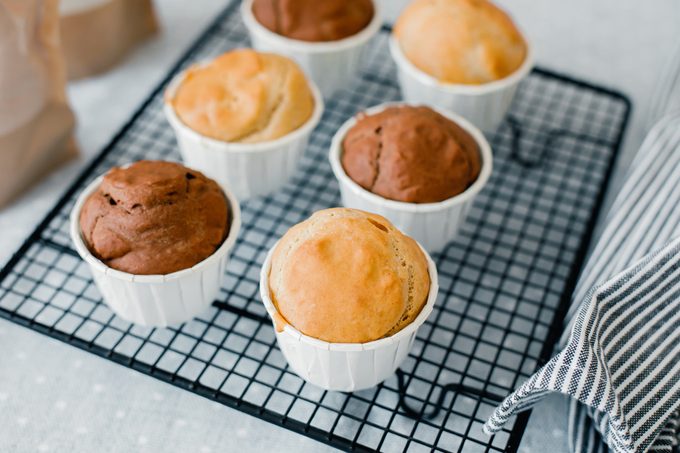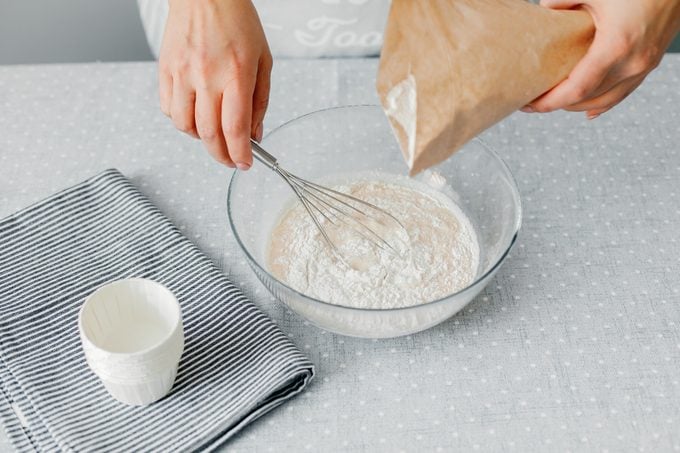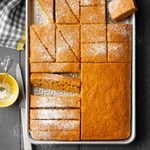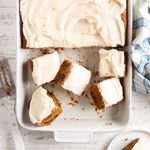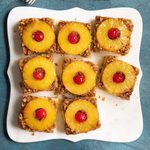Our Guide to Gluten-Free Baking

Gluten-free baking can seem daunting when you're just getting started, but we have everything you need to know.
Our editors and experts handpick every product we feature. We may earn a commission from your purchases.
I was in graduate school living across the country from my family doctor when I learned I couldn’t eat gluten. The nurse delivered the news somberly over the phone.
“What’s gluten?” I asked.
I honestly didn’t have the slightest idea of what gluten-free meant, let alone how to adapt to a gluten-free diet, grocery shop or eat at restaurants. I couldn’t even fathom gluten-free baking.
In the decade-plus since, I’ve become an accidental expert. It started with homemade gluten-free cookies, because I couldn’t afford a $9 store-bought box on a student budget. Then I learned to make pizza dough, because I’ve always loved homemade pizza. Fast-forward five years, and I was raising two sourdough starters (one sorghum and one teff, if you’re curious) and baking bread every weekend.
Gluten-free baking is different than traditional baking, but it’s not inherently worse. With practice, you can bake just about anything you used to make with wheat flour, and often have a lot more fun experimenting with different flavors and flours. Here’s everything you need to know.
What Is Gluten?
While almost everyone has heard of “gluten-free” by now, the actual definition of gluten is a bit hazier. Is it wheat? Is it flour? It’s neither! Gluten is actually a protein found in wheat, barley and rye, both in whole grain and processed form (like flour). Gluten is strong; it lends structural support to breads and other baked goods, and contributes to most of the chew in breads, bagels and buns. Unfortunately, gluten can be difficult to digest for some people—and in the case of those with celiac disease, it can actively cause harm.
What Does ‘Certified GF’ Mean?
Most foods are naturally gluten-free. This includes the obvious (meat, poultry, eggs, fruits and vegetables), as well as the specality grains that have become more common with the rise of gluten-free diets (think millet, sorghum, rice and buckwheat).
However, depending on how a food is grown, harvested and processed, even a naturally gluten-free food may be exposed to gluten-containing ingredients. This is called cross contamination. For example, oats might be transported alongside wheat, buckwheat may be milled on the same equipment as wheat flour or a plain chocolate bar may be packaged using the same machinery as cookies. Likewise, foods and supplements whose ingredients are more obscure, such as vitamins, might contain hidden sources of gluten.
This is where certification is important. A product that’s “certified gluten-free” is both free of gluten and has not been contaminated with gluten. It’s officially tested and certified as gluten-free, meeting strict standards. Certified foods are safe for sensitive eaters, such as those with celiac disease.
In general, you’ll see “certified gluten-free” labels on processed foods, such as baked goods, cereals, flours, baking ingredients, snacks, canned foods and condiments like salad dressings. Foods that aren’t labeled as certified gluten-free may still be gluten-free, but not officially tested. Depending on personal gluten sensitivities, you may eat them anyway or choose to avoid them.
What Baking Ingredients Contain Gluten?
It’s not always easy to tell whether a food contains gluten. Some ingredients are obvious. For instance, I can buy vital wheat gluten in the bulk bins at my co-op grocery. Others are sneaky sources of gluten. Here are some common gluten suspects:
Naturally Contains Gluten
- Wheat flour, including all-purpose, whole grain, cake flour and self-rising flour
- Ancient grain forms of wheat flour, including einkorn, emmer, durum and spelt
- Rye and pumpernickel
- Barley
Often Contains Gluten
- Cake and pudding mixes
- Malt powder and malted milk
- Sprinkles and candies (often contain sneaky hidden gluten)
- Brown rice syrups may contain barley
Often Cross-Contaminated
- Grains and starches that aren’t specifically certified gluten-free, including rice flour, potato starch, buckwheat, amaranth, teff and quinoa
- Oats or oat flour that isn’t certified gluten-free
- Corn flour, corn meal and corn starch
- Spices
- Chocolate (chocolate chips and cocoa powder may be processed with wheat)
- Nuts, both whole and ground
- Confectioners’ sugar
- Baking powder
- Vanilla and other extracts
- Anything in a bulk bin is at high risk of being cross-contaminated
One final major suspect? Wooden cooking utensils and cutting boards that have been in contact with gluten ingredients. If you cook both gluten and gluten-free in your kitchen, make sure to have separate tools for gluten-free baking, preferably silicone or plastic.
How to Make Recipes Gluten-Free
When transitioning to a gluten-free diet, the most common worry is whether you’ll ever eat your favorite foods again. The good news is that most recipes can be converted to gluten-free. It’s often easy to find a substitute that will serve the same purpose—using corn starch to thicken a sauce instead of flour, for example, or swapping a gluten-free flour mix in your morning pancake recipe.
To be honest, more complicated baked goods like cakes and breads or pastries like pies and tarts are trickier to bake gluten-free. There’s definitely a learning curve when going gluten-free, so here is our best advice:
- Find a good gluten-free recipe and follow it to the letter. Once you’ve made something GF, you’ll have a better sense of how to adapt your personal recipes.
- Gluten-free batter is almost always more wet than traditional batters, and gluten-free baked goods are almost always more dry. The more you practice, the more you’ll adjust to this new reality and tweak recipes and baking times accordingly.
- Never try to make a wheat bread recipe gluten-free. It just won’t work. Too much of wheat bread baking revolves around the role of gluten. Instead, learn to bake really good gluten-free bread.
- Be patient and have fun! The more you bake gluten-free, the more comfortable you’ll be. You might even enjoy exploring the wide world of gluten-free grains, which offer a huge variety of flavors, textures and recipes.
How Does Gluten-Free Baking Change Recipes?
Gluten’s role in traditional baked goods is hard to understate. Breads are kneaded and shaped in order to best activate and strengthen gluten. Pizzas are stretched and flung to work the gluten. Cakes are lightly stirred in fear of awakening too much gluten.
So, naturally, gluten-free baking is going to be different, in good ways and bad. First, there’s no fear of making any baked good tough. So go ahead and beat that cake batter, re-roll that pie dough and enjoy stirring up a bread dough in a stand mixer without breaking a sweat.
The downside? No gluten means less structure, less strength, less height, less stretch. To make up for this, most gluten-free baking recipes call for a binding agent that plays a similar role to gluten. Xantham gum, guar gum and psyllium husk are common binders, either added to the recipe or simply included in your flour mix. These binders make it possible to bake gluten-free bread that’s actually chewy and to achieve the loftiness of a fancy cake.
Gluten Free Flour 101
There are a ton of gluten-free flours out there, from boxed mixes to individual grains sourced from around the world. Here’s a quick guide to get you started.
The Best Gluten-Free Flours
All-Purpose Mixes
Many bakers like to use an all-purpose mix, which includes a blend of flours and starches that mimic the taste and texture of all-purpose wheat flour. Store-bought mixes are convenient and generally designed to replace standard all-purpose flour one-to-one. We like King Arthur Gluten-Free Measure for Measure Flour, which is highly rated for taste and texture and sold at a reasonable price point. Better Batter Original All Purpose Flour Blend won our top marks for most allergy-friendly mix.
Single Flours
For gluten-free baking, we like brown and white rice flours, which are versatile and mild-flavored. Brown rice has a heartier texture that works well in pancakes and muffins, while white rice is lighter and best for cakes. Millet flour has a warm, pleasant flavor, and oat flour is slightly sweet. Sorghum and corn flours lean more savory, but they are still quite mild and add a pleasant chew to breads, muffins and pizza crust.
How to Measure Gluten-Free Flour
The best way to measure flour is to fluff the flour so it’s not too packed, gently spoon flour into a measuring cup and swipe across with the flat side of a knife to level it off. Don’t dip your measuring cup directly in the bag, as that will pack the flour down and serve up a too-heavy scoop. Pouring the flour into the cup also results in overly packed flour, as well as a possible countertop mess.
How to Make Your Own Gluten-Free Flour
Making a homemade flour mix will save you money if you bake often, and it’s quite easy to do. Simply whisk together 2 cups white rice flour, 2/3 cup potato starch flour and 1/3 cup tapioca flour. Scale up the recipe if you bake often. Store in an airtight container in a cool, dry place.
How to Store Gluten-Free Baked Goods
The sad truth is that gluten-free baked goods don’t keep quite as well as traditional treats. But it’s not the worst fate! Generally, this only means you should eat them quickly.
As a rule of thumb, the more moist the bake, the longer it will keep. Scones and delicate cookies will last a day or two, while richer treats, like peanut butter cookies or breads, will keep a few days. Very moist bakes, like quick breads and muffins, will keep for several days.
Anything frosted with dairy ingredients should be kept in the fridge. Everything else keeps best at room temperature, wrapped tightly in an airtight container or a resealable plastic bag. Bread boxes and cookie jars are going to make things dry very quickly.
Afraid a bake will go stale? Freeze it! Almost anything can be frozen for one or two months, and it will taste nearly as good as when it was fresh. Muffins and unfrosted cupcakes, cookies, scones, quick breads (sliced or whole), unfrosted cake layers, breads, bagels and more can be frozen. Allow the baked goods to cool completely, then wrap tightly in at least two layers. Defrost overnight in the refrigerator, or heat in the microwave and eat immediately.

